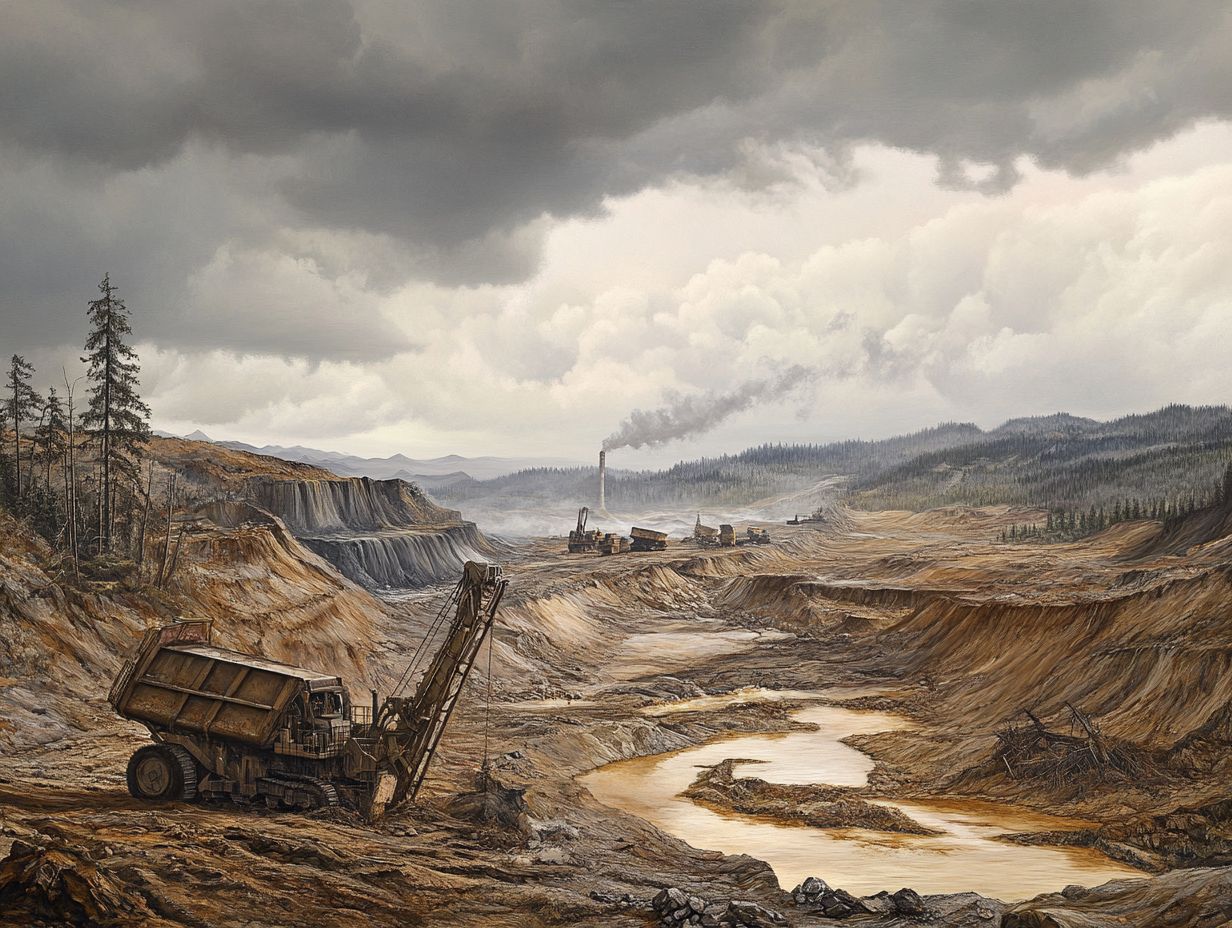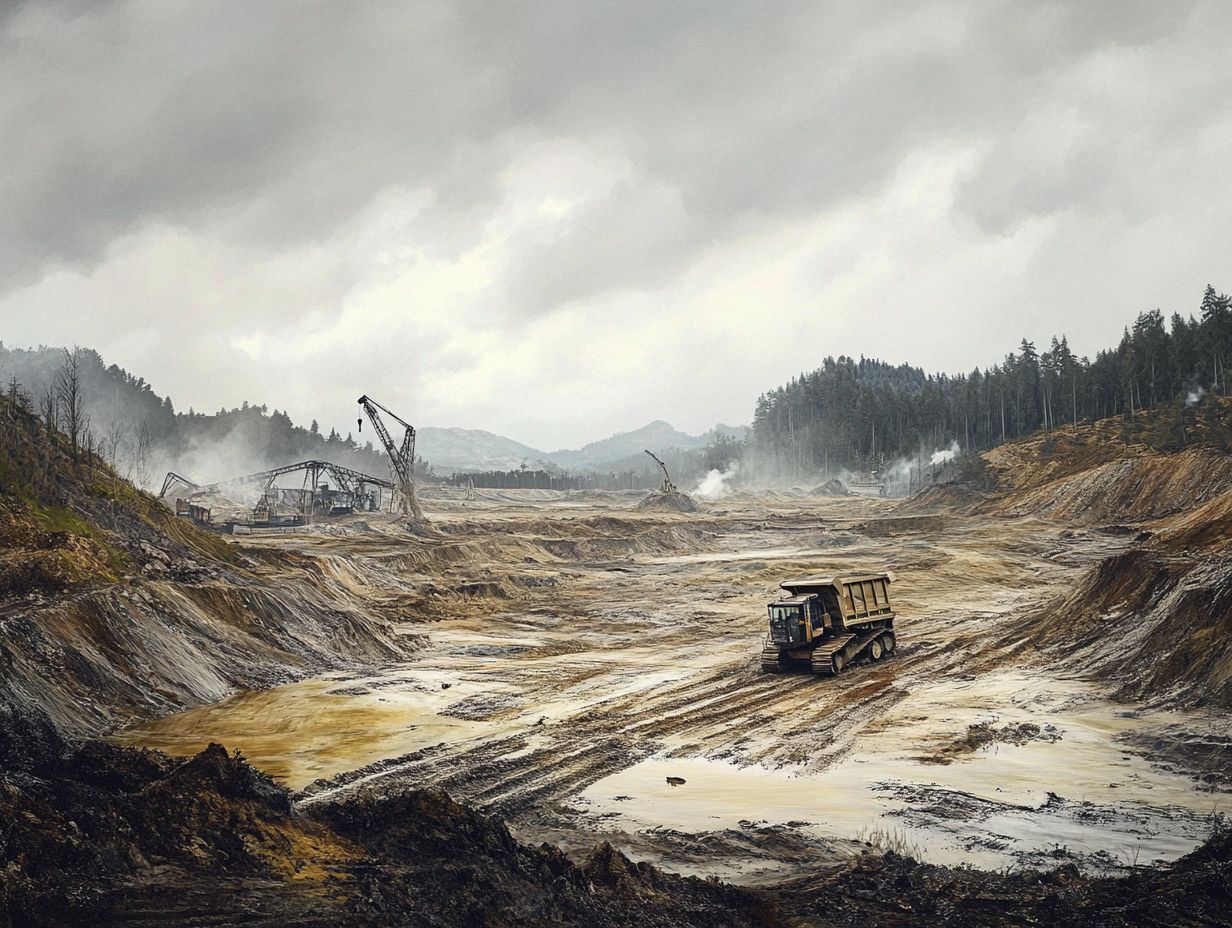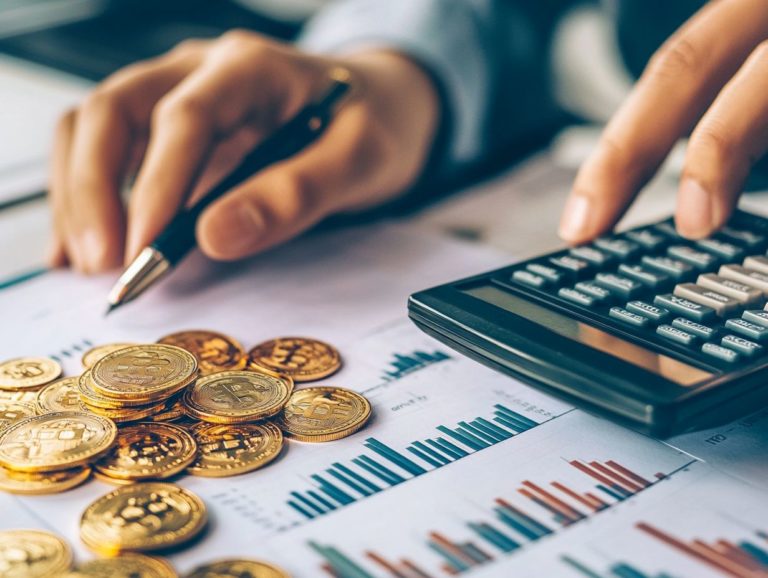What are the Environmental Impacts of Gold Mining?
Gold mining has historically been a catalyst for economic growth and technological progress. However, it carries a considerable environmental price.
Let s explore the exciting yet complex world of gold mining. This article looks at the methods and techniques used in gold extraction while shedding light on environmental issues, including pollution of water, land, and air.
We will also examine regulations and mitigation efforts designed to lessen these impacts. Additionally, we will consider the social and economic effects on local communities.
Engage with us as we unravel the intricate narrative of gold mining’s benefits and burdens.
Contents
- Key Takeaways:
- Overview of Gold Mining
- Environmental Impacts of Gold Mining
- Regulations and Mitigation Efforts
- Social and Economic Impacts of Gold Mining
- Frequently Asked Questions
- What are the Environmental Impacts of Gold Mining?
- How does gold mining contribute to deforestation?
- What are some potential water pollution effects of gold mining?
- What are the risks of air pollution from gold mining?
- How does gold mining impact local communities?
- What are some sustainable alternatives to traditional gold mining?
Key Takeaways:

- Gold mining has significant environmental impacts, including pollution of water, land degradation, and air pollution.
- Government regulations and industry standards aim to reduce these impacts, but more efforts are needed to lessen the environmental footprint of gold mining.
- The social and economic impacts of gold mining, including its effects on local communities and the associated benefits and costs, must urgently be considered to understand the full picture of this industry.
Overview of Gold Mining
Gold mining is a complex industry that plays a crucial role in the global economy. It also presents significant challenges in terms of the ability to keep the environment safe and community development.
This sector encompasses various methods, including hardrock mining, artisanal mining, and surface mining. Each method leaves its unique ecological footprint and societal impact.
Influential voices such as Mark Ashton, Nora Hardy, David Woodbury, and Shrabya Timsina underscore the urgent need for sustainable mining practices. These practices aim to reduce environmental damage and improve community welfare, addressing issues like deforestation and water pollution.
Methods and Techniques
Gold mining encompasses various techniques, including artisanal mining, surface mining, and hardrock mining. Each method comes with its own scale and environmental footprint.
Artisanal mining refers to small-scale operations using basic tools and manual labor. While accessible, it can also be somewhat inefficient.
In contrast, surface mining uses heavy machinery to strip away topsoil and extract gold directly from deposits. This method yields larger quantities but causes significant habitat disruption.
Hardrock mining involves digging deep into the ground to access gold veins, using advanced technologies like explosives and drilling equipment. While effective, this approach raises serious concerns regarding water resources and local ecosystems.
Navigating the balance between extraction methods and sustainable practices is essential for minimizing environmental impact.
Environmental Impacts of Gold Mining
The environmental impacts of gold mining are substantial, affecting ecosystems, water resources, and soil health. This industry contributes to critical issues such as water pollution, mercury contamination, and land degradation.
These effects not only jeopardize tropical forests and biodiversity but also raise serious concerns about the carbon footprint linked to gold production. Your awareness of these challenges is essential for understanding the broader implications of gold mining on our planet’s health.
Water Pollution
Water pollution affects local waterways. It poses serious health risks to nearby communities, increasing cases of respiratory issues and skin diseases.
This pollution can lead to long-term neurological problems. As these communities rely on these water sources for drinking, fishing, and agriculture, the broader ecological impacts become clear.
These effects often manifest as reduced fish populations and compromised soil quality. In response to these distressing effects, various remediation efforts are underway.
Improved waste management practices and the adoption of mercury-free extraction techniques are being explored. Environmental organizations and local governments are joining forces to raise awareness about the environmental impact of silver mining and advocate for sustainable mining practices, aiming to restore affected areas and safeguard community health.
Land Degradation

Land degradation is a pressing concern linked to gold mining. It results in deforestation and the loss of natural benefits like clean air and water, which are vital for plants and animals.
The extraction processes often disturb soil structure, water systems, and native flora and fauna. This further exacerbates habitat decline.
As heavy machinery clears expansive areas, it transforms the natural landscape. It also releases harmful pollutants into nearby waters, adversely impacting both aquatic and terrestrial life.
Acknowledging these consequences is vital for adopting sustainable mining practices. These practices can reduce environmental impacts and foster community development.
By emphasizing ecological restoration, mining operations can rejuvenate degraded landscapes, enhance biodiversity, and ensure local economies flourish in harmony with their natural environments.
Air Pollution
Air pollution stands as a significant yet often overlooked consequence of gold mining. It impacts both the health of local communities and the quality of the environment.
The extraction process releases harmful pollutants into the atmosphere. These include particulate matter, sulfur dioxide, and heavy metals.
As dust and toxic fumes spread through the air, they compromise the respiratory health of nearby residents. They also pose a threat to wildlife and ecosystems.
Prolonged exposure to these pollutants has been linked to serious health issues like asthma, lung cancer, and cardiovascular diseases. We must establish strong regulations now to protect our communities and our planet!
Regulations and Mitigation Efforts
Government regulations and industry standards are vital in reducing the environmental impacts of gold mining. They ensure that practices align with sustainability goals and community welfare.
The Responsible Gold Mining Principles established by the World Gold Council serve as a crucial guide for the mining industry. They steer it toward more sustainable practices.
Organizations like the EPA provide essential frameworks for effective environmental remediation and monitoring. These efforts help safeguard the ecosystem while promoting responsible mining practices.
Government Regulations and Industry Standards
Government regulations and industry standards are essential frameworks that ensure your gold mining operations align with principles of environmental sustainability and community health.
These guidelines are carefully designed to mitigate the negative impacts on ecosystems and promote responsible resource management. They also ensure you comply with best practices in environmental stewardship. Agencies like the Environmental Protection Agency (EPA) and various state-level entities outline requirements that you must adhere to, such as conducting thorough environmental impact assessments and implementing effective reclamation plans, which are strategies to restore land after mining is completed.
Organizations like the International Council on Mining and Metals (ICMM) champion sustainable practices that harmonize with social and economic goals. They guide you through the complexities of environmental regulations while helping you build positive relationships with local communities.
Efforts to Reduce Environmental Impact
Gold mining companies are now actively minimizing their environmental impact by embracing sustainable practices and innovative green technologies to lessen their ecological footprint.
This shift is largely fueled by an increasing awareness among stakeholders regarding the long-term consequences of traditional mining methods on ecosystems and local communities.
Numerous initiatives are demonstrating how cutting-edge solutions, such as water recycling systems and methods to clean up polluted areas using natural processes, can effectively restore contaminated sites.
A standout example is a community-led project that transformed a polluted landscape into a thriving habitat, showcasing the profound impact of local engagement.
By merging responsible mining practices with active community outreach, stakeholders are not only conserving natural resources but also nurturing a culture of stewardship that highlights the significance of sustainable mining for future generations. It’s crucial to act now to protect our environment for the future.
Social and Economic Impacts of Gold Mining

The social and economic impacts of gold mining present a complex tapestry, intertwining substantial benefits with notable costs to local communities and global markets.
While the insatiable demand for gold fuels economic growth, it also carries the potential for adverse effects on communities, including displacement and environmental degradation.
Balancing these dynamics is crucial for fostering sustainable development in the face of such lucrative yet challenging endeavors.
Impact on Local Communities
The impact of gold mining on local communities can be truly profound, offering a mix of economic opportunities through employment and community development, while also bringing challenges like health impacts and social disruption.
On one hand, the surge of jobs tied to mining can significantly boost the local economy, providing residents with a reliable income and paving the way for infrastructure improvements.
Local businesses often flourish as the demand for goods and services rises, injecting new life into the community.
However, these benefits come with a price; the health implications of gold mining can be severe, as heavy metals and toxic byproducts may infiltrate local water sources, posing serious health risks.
The social dynamics can shift dramatically as mining operations attract workers from outside the community. This influx can lead to heightened competition for resources and, in some cases, social tension among residents.
It’s a complex tapestry of opportunity and challenge that requires careful navigation. Join the movement towards sustainable mining practices that benefit both communities and the environment.
Economic Benefits and Costs
Gold mining reveals a complicated mix of economic benefits and costs. It affects local economies and influences global gold demand.
The industry creates many job opportunities, providing income stability for families in mining areas.
Revenue from gold mining often supports essential local infrastructure projects like schools and roads. These projects help communities grow in the long term.
However, pursuing gold has challenges. Environmental damage and disruption to local ecosystems can occur.
Communities may struggle as population shifts from mining activities strain resources and change cultural practices. We must weigh immediate benefits against future sustainability.
Frequently Asked Questions
What are the Environmental Impacts of Gold Mining?
Gold mining dramatically affects our environment. Key impacts include deforestation, water pollution, and air pollution.
How does gold mining contribute to deforestation?

Gold mining often requires clearing large land areas, which leads to deforestation and loss of biodiversity.
What are some potential water pollution effects of gold mining?
Gold mining can release toxic chemicals, like cyanide, into nearby waters. This can contaminate water supplies and harm aquatic life.
What are the risks of air pollution from gold mining?
Mining activities can emit airborne pollutants such as dust and sulfur dioxide. These can harm human health and contribute to acid rain.
How does gold mining impact local communities?
Gold mining can have negative effects on local communities, including displacement of indigenous peoples and loss of livelihoods.
What are some sustainable alternatives to traditional gold mining?
Some sustainable alternatives include using recycled gold and promoting responsible mining practices. This involves reducing harmful chemicals and restoring mined land.












